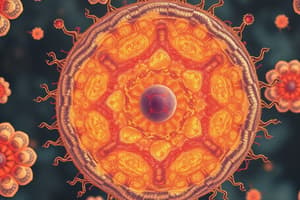Podcast
Questions and Answers
What is the function of the nucleus in a cell?
What is the function of the nucleus in a cell?
- Regulating cell size
- Storing genetic instructions (correct)
- Facilitating cell division
- Synthesizing proteins
Which type of cells lack membrane-bound nuclei?
Which type of cells lack membrane-bound nuclei?
- Animal cells
- Eukaryotic cells
- Prokaryotic cells (correct)
- Plant cells
What is the role of organelles in a cell?
What is the role of organelles in a cell?
- Performing specific activities (correct)
- Storing genetic material
- Regulating cell division
- Generating energy
What determines the structure and functioning of a multicellular organism?
What determines the structure and functioning of a multicellular organism?
What is a key factor in ensuring proper development and normal functioning of an organism?
What is a key factor in ensuring proper development and normal functioning of an organism?
In terms of size, what type of eukaryotic cells can be over one meter wide?
In terms of size, what type of eukaryotic cells can be over one meter wide?
Flashcards are hidden until you start studying
Study Notes
A cell is the smallest unit of life capable of performing all the functions necessary to sustain itself independently. Cells make up every living organism on Earth—from bacteria to plants to humans. They vary greatly in size, shape, and complexity, depending on their function within the body. For instance, cells can range from a few micrometers across, such as prokaryotic bacterial cells, to over one meter wide, like plant guard cells found in leaves. In multicellular organisms, different types of cells perform specialized tasks, and these specializations determine the structure and functioning of the whole organism.
Cells have two main categories: prokaryotic cells and eukaryotic cells. Prokaryotes lack membrane-bound nuclei; instead, they contain circular DNA molecules inside them. Eukaryotic cells, which include human cells, have a more complex internal organization with several separate compartments delineated by membranes. One of the most important components inside a cell is its nucleus, where genetic instructions are stored. Other components include various structures called organelles, each responsible for specific activities essential to the cell's survival, growth, and reproduction.
The ability of cells to divide allows new cells to be produced when needed, providing replacement tissue and facilitating repair. This process also helps maintain a precise number of cells, which is crucial for proper development and normal functioning. Each time a cell divides, it replicates the entirety of its chromosomes before dividing into two daughter cells. Dividing cells come together during embryonic development to form tissues and organs, eventually creating a fully developed whole organism.
In summary, a cell is the basic structural and functional unit of life, serving as both a building block and an independent unit capable of carrying out the processes required to keep living things alive. Different kinds of cells exist according to their level of organization, and while some cells may look similar, there are profound differences between cells based on the type of organism they belong to. Regardless of these variations, however, all cells share certain common features that define what makes any given thing a living entity.
Studying That Suits You
Use AI to generate personalized quizzes and flashcards to suit your learning preferences.




